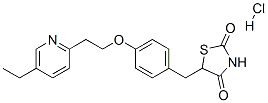Albiglutide
- CAS NO.:782500-75-8
- Empirical Formula: C148H223N39O46
- Molecular Weight: 3284.58792
- MDL number: MFCD27976663
- Update Date: 2024-11-13 11:39:26

What is Albiglutide?
General Description
Albiglutide (also known as naliglutide, GSK 716155) isa sequential dimer of GLP-1(7–36)(Ala8→Gly) covalentlylinked to modified human serum albumin (i.e., it is a “fusionprotein” with modified HSA). This molecule is currentlywell into phase III clinical trials. Although albiglutide,if marketed (Syncria, GlaxoSmithKline), will—likeexenatide—be administered by injection, the half-life andduration of 6 to 7 days would allow for weekly administration.
Clinical Use
GLP-1 receptor agonist:
Treatment of type 2 diabetes mellitus
Enzyme inhibitor
This GLP-1 agonist and anti-diabetic drug (MW = 72.9 kDa; CAS 782500- 75-8), marketed as Eperzan? and Tanzeum?, by GlaxoSmithKline (GSK) is a dipeptidyl peptidase-4-resistant glucagon-like peptide-1 dimer fused to human albumin. Albiglutide has a half-life of 4-7 days, commending it for biweekly or weekly administration in the treatment of Type 2 diabetes. The half-life is considerably longer than exenatide (Byetta?) and liraglutide (Victoza?).
Metabolism
Albiglutide is a protein for which the expected metabolic pathway is degradation to small peptides and individual amino acids by ubiquitous proteolytic enzymes.
Properties of Albiglutide
| storage temp. | Store at -20°C |
| Water Solubility | Water: 100 mg/mL (30.45 mM); |
Safety information for Albiglutide
Computed Descriptors for Albiglutide
| InChIKey | OGWAVGNOAMXIIM-VTAHJYCESA-N |
New Products
Tert-butyl bis(2-chloroethyl)carbamate 4-Methylphenylacetic acid N-Boc-D-alaninol N-BOC-D/L-ALANINOL N-octanoyl benzotriazole 3-Morpholino-1-(4-nitrophenyl)-5,6-dihydropyridin- 2(1H)-one Furan-2,5-Dicarboxylic Acid DIETHYL AMINOMALONATE HYDROCHLORIDE 1,1’-CARBONYLDIIMIDAZOLE R-2-BENZYLOXY PROPIONIC ACID 1,1’-CARBONYLDI (1,2-4 TRIAZOLE) N-METHYL INDAZOLE-3-CARBOXYLIC ACID (2-Hydroxyphenyl)acetonitrile 4-Bromopyrazole 5-BROMO-2CYANO PYRIDINE 5,6-Dimethoxyindanone 5-broMo-2-chloro-N-cyclopentylpyriMidin-4-aMine 2-(Cyanocyclohexyl)acetic acid 4-methoxy-3,5-dinitropyridine 1-(4-(aminomethyl)benzyl)urea hydrochloride 2-aminopropyl benzoate hydrochloride diethyl 2-(2-((tertbutoxycarbonyl)amino) ethyl)malonate tert-butyl 4- (ureidomethyl)benzylcarbamate Ethyl-2-chloro((4-methoxyphenyl)hydrazono)acetateRelated products of tetrahydrofuran








You may like
-
 2033-24-1 98%View Details
2033-24-1 98%View Details
2033-24-1 -
 1975-50-4 98%View Details
1975-50-4 98%View Details
1975-50-4 -
 2-HYDROXY BENZYL ALCOHOL 98%View Details
2-HYDROXY BENZYL ALCOHOL 98%View Details
90-01-7 -
 2-Chloro-1,3-Bis(Dimethylamino)Trimethinium Hexafluorophosphate 221615-75-4 98%View Details
2-Chloro-1,3-Bis(Dimethylamino)Trimethinium Hexafluorophosphate 221615-75-4 98%View Details
221615-75-4 -
 61397-56-6 CIS BROMO BENZOATE 98%View Details
61397-56-6 CIS BROMO BENZOATE 98%View Details
61397-56-6 -
 14714-50-2 (2-Hydroxyphenyl)acetonitrile 98+View Details
14714-50-2 (2-Hydroxyphenyl)acetonitrile 98+View Details
14714-50-2 -
 118753-70-1 98+View Details
118753-70-1 98+View Details
118753-70-1 -
 733039-20-8 5-broMo-2-chloro-N-cyclopentylpyriMidin-4-aMine 98+View Details
733039-20-8 5-broMo-2-chloro-N-cyclopentylpyriMidin-4-aMine 98+View Details
733039-20-8